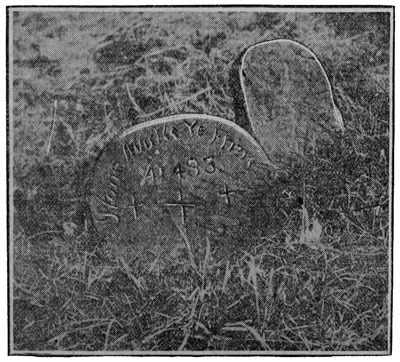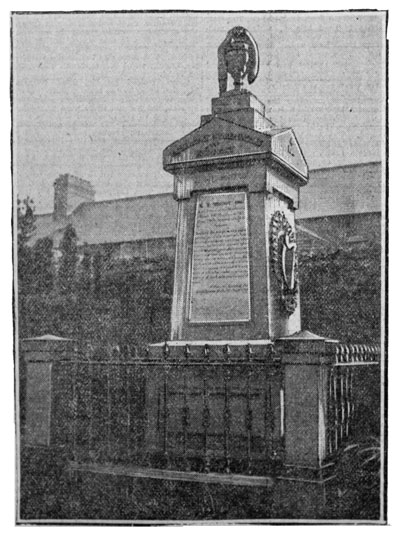Belfast Evening Telegraph, Tuesday, October 16, 1906
II -- Historic Memorial Stones
"Friar's Bush" is so called from the tree or bush in the centre of the burying ground at which the ancient Friar is said to have performed his daily devotions. Close to this tree are to be found a couple of ancient-looking stones, so bowed down with the weight of their hundreds of years as almost to escape attention. According to the inscription on the larger of the two,
This Stone Marks Ye Friar's Grave
A.D. 483
and it is said that the smaller stone at one time contained the details of the Friar's death, which details were afterwards carved in quaint characters on the memorial.

This "cup" or receptacle is still to be seen, and lest there should be any doubt in the minds of readers as to correctness of the date, I photographed the stone -- a rather difficult job considering its position -- and am pleased to be able to reproduce this curiosity herewith. If the engravers of the inscription have not made any mistake, then the friar must surely Have been a disciple of St. Patrick who visited this district some time previously. It is recorded, however, that on this spot there was a friary named Capella de Kilpatrick, and it was supposed to be an alterage to Shankill. Benn in compiling his History of Belfast has had difficulty in getting much definite information about the place, even from the time it began to be used for burial purposes, and the friary may have been there centuries previous to that, although termed an alterage to Shankill in the fifteenth century.
For the benefit of those who may not know this ancient burying ground I may explain that it is situated on the Stranmillis Road, and forms as it were a corner of the Botanic Gardens Park. The wall protrudes beyond the other buildings as if to claim attention, and the entrance gate still bears a trace of medievalism, with its quaint Early English archway.
As in Shankill people of all creeds were interred here. Many of the older stones are hidden in the undergrowth, the tops only being visible, while others have become securely fixed in such awkward positions as to be altogether indecipherable.
The following is one of the oldest available, and reminds us that there was a period during which the bereaved considered it prudent to advertise their calling or profession when an opportunity offered:-
Here the Lyeth the Body
Of Agnas the wife of
John McMun of Belfast
Tallow Chandler who
Departed this life the
12 day of Oct. 1737 in the
35 year of her age
It is curious to notice the spelling "Agnas" and as it occurs on several tombstones of the same period we may take it for granted that it was then considered the correct form, but the ingenuous manner in which the profession of the survivor is introduced, is quite as interesting. A John McMun is mentioned in an entry detailing expenses for Rosemary Street Church about this time, and is probably the same person, as the name is uncommon. It is amazing when one looks back and realises what was happening during Mrs McMun's short lifetime. Born a few months after the death of William III. she lived during the reign of one Queen and two Kings. Queen Anne and the first and second of the Georges, when the principal streets of Belfast were flanked with thatched cottages, when the fashionable sport hereabouts was cockfighting in the morning, and a ball for the ladies in the evening. When she was six years old Belfast Castle was burnt, and burials at night were quite common. It was unusual in those days to give the inns quaint names, such as "The Sign of the Sun." "Adam and Eve." or "Eagle and Child," all of which were popular hostelries in the days when Dr. Joseph Black, the eminent chemist and philosopher, was a prominent figure in local history.
The next memorial in seniority is a sort of rectangular vault built on the highest part of the grounds, and above the iron gate there is a modern-looking metal tablet which announces that this is, or was, the family burying-ground of Charles Lennon, and the date is given as "1760", I pushed aside the iron gate, and looked reverently into this building, but the walls were quite bare. There was a pathetic loneliness about this temple -- as if the race had died out or had migrated to other lands, leaving the care of those once dear, to strangers and the great future. On the sanded floor lay the withered remains of several wreaths which had been deposited there in the long ago to mark the fact that those who rested below were not forgotten. I pulled the door quietly behind me and wandered further in search of something less pitiful. My attention was attracted to a pretentious monument of modern style, elaborately carved. It was particularly distinctive among the surroundings, and on reading the inscription my interest was at once awakened,
ERECTED by the REPEALERS
of
BELFAST
In memory of
K. T. BUGGY, Esq,
Late Editor of the Vindicator.
Born 5th Mar. A.D., 1817,
Died 18th Aug., 1843.
is rather remarkable that this man who commanded such respect among his colleagues was only 26 years of age when he died. The famous Daniel O'Donnell referred to him in his speech at the Conciliation Hall, on 14th September, 1843, and his remarks are quoted at length on the monument:-
"Ireland did not possess a purer patriot, nor did a truer Irish heart than his ever throb within an Irish bosom. An honester, sincerer, more single-hearted, more disinterested man never trod the earth. His early grave was an honoured one. He died amidst the tears of all who knew him, and the heart felt anguish of all who could appreciate purity of soul and manliness of spirit."

On the opposite side of the graveyard, in a secluded corner, as if not courting inspection or publicity, is another monument to a journalist who lived a decade later, and occupied the position of editor of the "Northern Star," but long after its stormy days had passed --
To the memory of
ANDREW JOSEPH McKENNA,
Born at Cavan, Nov. 1, 1833: died at Holywood
4th April, 1872.
According to the inscription -
"Gifted with genius of a high order, he displayed powers of public speaking which, had his life been spared, must have secured him a name and fame among the orators of his native land.
His premature decease having deprived his country of his services and consigned to an early grave the hopes of his many friends.
A few of these friends of all shades of opinion have joined in erecting this monument to his memory.
RIP
Close to the Buggy Memorial, almost hidden beneath the thick branches of a straggling tree, is a stone covered with moss and lichen, and it is with difficulty we can make out the inscription:-
FELIN MAGINNES
Police Inspector of Belfast
Died 1831.
Here follows a list of daughters, and finally his wife who departed this life in 1859. She was born in 1783 and lived during the times of George III., George IV., William IV., and Queen Victoria -- in the days of the famous Dr. Drennan, Dr. Halliday, and the "Hearts of Steel;", when Peter's Hill was a favourite residential district, with it's gardens, it's orchards, its bull baitings, and its races. Although no word of his greatness appears on his tombstone, it may be taken for granted that a police inspector in those days occupied no sinecure. Perhaps the name and the date were considered sufficient. As I have explained, there are very few old stones available -- none beside those I have mentioned further back than 1733 as the date of birth, but there are many interesting memorials to more modern local notabilities, such as Bernard Hughes, Philip Jordan, of Jordanstown, and others. The quaint little enclosure is well worth a visit, if only to inspect
YE FRIAR'S GRAVE

